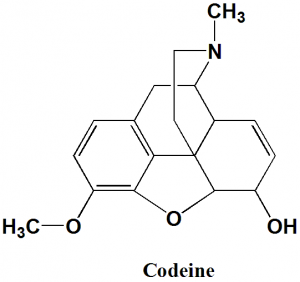CODEINE Synthesis, SAR, MCQ, Structure, Chemical Properties and Therapeutic Uses
Codeine
IUPAC nomenclature
(5α,6α)-7,8-didehydro-4,5-epoxy-3-methoxy-17-methylmorphinan-6-ol.
Classification
- Opiate (narcotic) analgesics
- Antitussives
Physiochemical Properties
| S. NO. | PHYSICAL AND CHEMICAL PROPERTIES | |
| 1 | Molecular weight | 299.4g/mol |
| 2 | Physical appearance | Colorless to white crystalline solid |
| 3 | Melting point | 157.5°C |
| 4 | Solubility | Soluble in water |
| 5 | Octanol/water partition coefficient | 1.19 |
| 6 | Presence of ring | Piperidine, tetrahydrofuran, cyclohexene, phenyl |
| 7 | Number of chiral centers | 5 |
Mechanism of Action
- Codeine is selective agonist for mu opioid receptors. Mu opioids receptors are responsible for the transmission of pain signals throughout the body. Codeine binds with these receptors and produces effect.
- Codeine analgesic property is also due to conversion into morphine inside the body.
Structure Activity Relationship
SAR for Opiates can be summarized as follows:
- Replacement of phenolic hydroxyl into –OCH3/-OC2H5 will make the drug less analgesic and cough suppression will also takes place.
- Replacement of alcoholic hydroxyl with –OCH3 makes the compound 5 times more active.
- Replacement of alcoholic hydroxyl with -OC2H5 makes the compound 2.4 times more active than morphine.
- Replacement of alcoholic hydroxyl with –OCOCH3 will also activates the compound by 4.2 times.
- Replacement of alcoholic hydroxyl with ketone group inactivates the compound and makes it lesser active.
- By hydrogenation of alicyclic unsaturated linkage, activity increases by 1.2 times.
- On replacement of the methyl group from tertiary nitrogen by hydrogen atom, activity decreases.
- On replacement of N-CH3 by NCH2CH2Ph, activity increases by 14 times.
- When the methyl group of tertiary nitrogen replaced by N-allyl/methallyl/propyl, the compound so formed acts like the Morphine antagonist.
- When the methyl group of tertiary nitrogen replaced by N(CH3)2 Cl– , compound have curare action and it do not possesses any analgesic activity.
Method of synthesis
Codeine is synthesized by methylation of the 3-hydroxy group of the morphine ring by trimethylphneylammonium ethoxide. [1]
Therapeutic Uses
Codeine is used for:
- Relief from mild to moderately severe pain
Side Effects
Side effects of Codeine are:
- Respiratory depression
- Circulatory depression
- Respiratory arrest
- Shock
- Cardiac arrest
- Drowsiness
- Lightheadedness
- Nausea
- Vomiting
- Sweating
- Shortness of breath
- Sedation
- Dizziness
- Constipation
- Euphoria
- Dysphoria
- Abdominal pain
- Pruritis
- Hypotension
- Palpitations
- Syncope
- Diarrhea
- Anorexia
- Pancreatitis
- Dry mouth
- Anxiety
- Headache
- Somnolence
- Weakness
- Vertigo
- Insomnia
- Visual problems
MCQs
Q.1 What can be the correct IUPAC nomenclature of Codeine?
a) (5α,6α)-7-hydro-4,5-epoxy-3-ethoxy-17-methylmorphinan-6-ol
b) 5-Ethyl-5-phenyl-1,3-diazinane-4,6-dione
c) (5α,6α)-7,8-didehydro-4,5-epoxy-3-methoxy-17-methylmorphinan-6-ol
d) 2-chloro-1,1-difluoro-1-methoxyethane
Q.2 Which amongst the following statements is/are incorrect related to the SAR of Opiates?
I. By hydrogenation of alicyclic unsaturated linkage, activity decreases by 1.2 times.
II. On replacement of the methyl group from tertiary nitrogen by hydrogen atom, activity decreases.
III. On replacement of N-CH3 by NCH2CH2Ph, activity increases by 14 times.
a) I, II
b) I
c) III
d) II, III
Q.3 Codeine can be synthesized by methylation of ?
a) Meperidine
b) Morphine
c) Loperamide
d) Anilerdine
Q.4 Side effects of drug Codeine is/are?
a) Respiratory depression
b) Circulatory depression
c) Cardiac arrest
d) All of the above
Q.5 Match the following drugs with their correct molecular weight.
| i. Codeine | A. 299.4 gm/mol |
| ii. Ethosuximide | B. 212.25 gm/mol |
| iii. Clobazam | C. 300.74 gm/mol |
| iv. Butabarbital | D. 141.17 gm/mol |
a) i-A, ii-D, iii-C, iv-B
b) i-B, ii-A, iii-D, iv-C
c) i-A, ii-C, iii-D, iv-B
d) i-D, ii-C, iii-A, iv-B
Q.6 An example of drug from class Narcotic analgesic is?
a) Molindone
b) Valproic acid
c) Codeine
d) Gluthemide
Q.7 The type of ring system found in the structure of Codeine is?
a) Piperidine
b) Tetrahydrofuran
c) Cyclohexane
d) All of the above
Participate in Online FREE GPAT TEST: CLICK HERE
Participate in Online FREE Pharmacist TEST: CLICK HERE
Participate in Online FREE Drug Inspector TEST: CLICK HERE
ANSWERS
1-c
2-b
3-b
4-d
5-a
6-c
7-d

